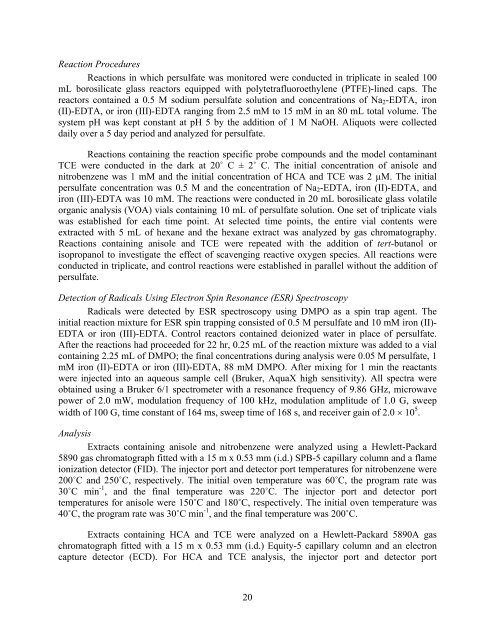Final Report - Strategic Environmental Research and Development ...
Final Report - Strategic Environmental Research and Development ...
Final Report - Strategic Environmental Research and Development ...
Create successful ePaper yourself
Turn your PDF publications into a flip-book with our unique Google optimized e-Paper software.
Reaction ProceduresReactions in which persulfate was monitored were conducted in triplicate in sealed 100mL borosilicate glass reactors equipped with polytetrafluoroethylene (PTFE)-lined caps. Thereactors contained a 0.5 M sodium persulfate solution <strong>and</strong> concentrations of Na 2 -EDTA, iron(II)-EDTA, or iron (III)-EDTA ranging from 2.5 mM to 15 mM in an 80 mL total volume. Thesystem pH was kept constant at pH 5 by the addition of 1 M NaOH. Aliquots were collecteddaily over a 5 day period <strong>and</strong> analyzed for persulfate.Reactions containing the reaction specific probe compounds <strong>and</strong> the model contaminantTCE were conducted in the dark at 20˚ C ± 2˚ C. The initial concentration of anisole <strong>and</strong>nitrobenzene was 1 mM <strong>and</strong> the initial concentration of HCA <strong>and</strong> TCE was 2 µM. The initialpersulfate concentration was 0.5 M <strong>and</strong> the concentration of Na 2 -EDTA, iron (II)-EDTA, <strong>and</strong>iron (III)-EDTA was 10 mM. The reactions were conducted in 20 mL borosilicate glass volatileorganic analysis (VOA) vials containing 10 mL of persulfate solution. One set of triplicate vialswas established for each time point. At selected time points, the entire vial contents wereextracted with 5 mL of hexane <strong>and</strong> the hexane extract was analyzed by gas chromatography.Reactions containing anisole <strong>and</strong> TCE were repeated with the addition of tert-butanol orisopropanol to investigate the effect of scavenging reactive oxygen species. All reactions wereconducted in triplicate, <strong>and</strong> control reactions were established in parallel without the addition ofpersulfate.Detection of Radicals Using Electron Spin Resonance (ESR) SpectroscopyRadicals were detected by ESR spectroscopy using DMPO as a spin trap agent. Theinitial reaction mixture for ESR spin trapping consisted of 0.5 M persulfate <strong>and</strong> 10 mM iron (II)-EDTA or iron (III)-EDTA. Control reactors contained deionized water in place of persulfate.After the reactions had proceeded for 22 hr, 0.25 mL of the reaction mixture was added to a vialcontaining 2.25 mL of DMPO; the final concentrations during analysis were 0.05 M persulfate, 1mM iron (II)-EDTA or iron (III)-EDTA, 88 mM DMPO. After mixing for 1 min the reactantswere injected into an aqueous sample cell (Bruker, AquaX high sensitivity). All spectra wereobtained using a Bruker 6/1 spectrometer with a resonance frequency of 9.86 GHz, microwavepower of 2.0 mW, modulation frequency of 100 kHz, modulation amplitude of 1.0 G, sweepwidth of 100 G, time constant of 164 ms, sweep time of 168 s, <strong>and</strong> receiver gain of 2.0 × 10 5 .AnalysisExtracts containing anisole <strong>and</strong> nitrobenzene were analyzed using a Hewlett-Packard5890 gas chromatograph fitted with a 15 m x 0.53 mm (i.d.) SPB-5 capillary column <strong>and</strong> a flameionization detector (FID). The injector port <strong>and</strong> detector port temperatures for nitrobenzene were200˚C <strong>and</strong> 250˚C, respectively. The initial oven temperature was 60˚C, the program rate was30˚C min -1 , <strong>and</strong> the final temperature was 220˚C. The injector port <strong>and</strong> detector porttemperatures for anisole were 150˚C <strong>and</strong> 180˚C, respectively. The initial oven temperature was40˚C, the program rate was 30˚C min -1 , <strong>and</strong> the final temperature was 200˚C.Extracts containing HCA <strong>and</strong> TCE were analyzed on a Hewlett-Packard 5890A gaschromatograph fitted with a 15 m x 0.53 mm (i.d.) Equity-5 capillary column <strong>and</strong> an electroncapture detector (ECD). For HCA <strong>and</strong> TCE analysis, the injector port <strong>and</strong> detector port20

















